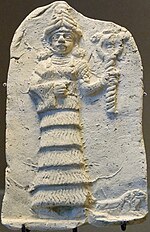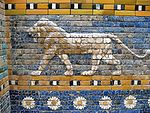Ishtar

Ishtar (pronounced /ˈɪʃtɑːr/; Transliteration: DIŠTAR; Akkadian: 𒀭𒈹 ![]()
![]() ; Sumerian 𒀭𒌋𒁯) is the Assyrian and Babylonian goddess of fertility, war, love, and sex.[1] She is the counterpart to the Sumerian Inanna and to the cognate north-west Semitic goddess Astarte.
; Sumerian 𒀭𒌋𒁯) is the Assyrian and Babylonian goddess of fertility, war, love, and sex.[1] She is the counterpart to the Sumerian Inanna and to the cognate north-west Semitic goddess Astarte.
Characteristics
Ishtar was the goddess of love and war, above all associated with sexuality: her cult involved sacred prostitution;[2][3] her holy city Uruk was called the "town of the sacred courtesans"; and she herself was the "courtesan of the gods".[4] Ishtar had many lovers; however, as Guirand notes,
"Woe to him whom Ishtar had honoured! The fickle goddess treated her passing lovers cruelly, and the unhappy wretches usually paid dearly for the favours heaped on them. Animals, enslaved by love, lost their native vigour: they fell into traps laid by men or were domesticated by them. 'Thou has loved the lion, mighty in strength', says the hero Gilgamesh to Ishtar, 'and thou hast dug for him seven and seven pits! Thou hast loved the steed, proud in battle, and destined him for the halter, the goad and the whip.' Even for the gods Ishtar's love was fatal. In her youth the goddess had loved Tammuz, god of the harvest, and—if one is to believe Gilgamesh—this love caused the death of Tammuz.[4]
Ishtar was the daughter of Ninurta.[4] She was particularly worshipped at the Assyrian cities of Nineveh, Ashur and Arbela (Erbil).[4]
Besides the lions on her gate, her symbol is an eight-pointed star.[5]



In the Babylonian pantheon, she "was the divine personification of the planet Venus".[4]
Descent into the underworld
One of the most famous myths[6] about Ishtar describes her descent to the underworld. In this myth, Ishtar approaches the gates of the underworld and demands that the gatekeeper open them:
If thou openest not the gate to let me enter,
I will break the door, I will wrench the lock,
I will smash the door-posts, I will force the doors.
I will bring up the dead to eat the living.
And the dead will outnumber the living.
The gatekeeper hurried to tell Ereshkigal, the Queen of the Underworld. Ereshkigal told the gatekeeper to let Ishtar enter, but "according to the ancient decree".
The gatekeeper lets Ishtar into the underworld, opening one gate at a time. At each gate, Ishtar has to shed one article of clothing. When she finally passes the seventh gate, she is naked. In rage, Ishtar throws herself at Ereshkigal, but Ereshkigal orders her servant Namtar to imprison Ishtar and unleash sixty diseases against her.
After Ishtar descends to the underworld, all sexual activity ceases on earth. The god Papsukal reports the situation to Ea, the king of the gods. Ea creates an intersex being called Asu-shu-namir and sends it to Ereshkigal, telling it to invoke "the name of the great gods" against her and to ask for the bag containing the waters of life. Ereshkigal is enraged when she hears Asu-shu-namir's demand, but she has to give it the water of life. Asu-shu-namir sprinkles Ishtar with this water, reviving her. Then Ishtar passes back through the seven gates, getting one article of clothing back at each gate, and is fully clothed as she exits the last gate.
Here there is a break in the text of the myth, which resumes with the following lines:
If she (Ishtar) will not grant thee her release,
To Tammuz, the lover of her youth,
Pour out pure waters, pour out fine oil;
With a festival garment deck him that he may play on the flute of lapis lazuli,
That the votaries may cheer his liver. [his spirit]
Belili [sister of Tammuz] had gathered the treasure,
With precious stones filled her bosom.
When Belili heard the lament of her brother, she dropped her treasure,
She scattered the precious stones before her,
"Oh, my only brother, do not let me perish!
On the day when Tammuz plays for me on the flute of lapis lazuli, playing it for me with the porphyry ring.
Together with him, play ye for me, ye weepers and lamenting women!
That the dead may rise up and inhale the incense."
Formerly, scholars[4][7] believed that the myth of Ishtar's descent took place after the death of Ishtar's lover, Tammuz: they thought Ishtar had gone to the underworld to rescue Tammuz. However, the discovery of a corresponding myth[8] about Inanna, the Sumerian counterpart of Ishtar, has thrown some light on the myth of Ishtar's descent, including its somewhat enigmatic ending lines. According to the Inanna myth, Inanna can only return from the underworld if she sends someone back in her place. Demons go with her to make sure she sends someone back. However, each time Inanna runs into someone, she finds him to be a friend and lets him go free. When she finally reaches her home, she finds her husband Dumuzi (Babylonian Tammuz) seated on his throne, not mourning her at all. In anger, Inanna has the demons take Dumuzi back to the underworld as her replacement. Dumuzi's sister Geshtinanna is grief-stricken and volunteers to spend half the year in the underworld, during which time Dumuzi can go free. The Ishtar myth presumably had a comparable ending, Belili being the Babylonian equivalent of Geshtinanna.[9] There are of course interesting parallels in the Graeco-Roman myths of Orpheus and of Persephone.
Ishtar in the Epic of Gilgamesh
The Epic of Gilgamesh contains an episode[10] involving Ishtar which portrays her as bad-tempered, petulant and spoiled by her father.
She asks the hero Gilgamesh to marry her, but he refuses, citing the fate that has befallen all her many lovers:
Listen to me while I tell the tale of your lovers. There was Tammuz, the lover of your youth, for him you decreed wailing, year after year. You loved the many-coloured Lilac-breasted Roller, but still you struck and broke his wing [...] You have loved the lion tremendous in strength: seven pits you dug for him, and seven. You have loved the stallion magnificent in battle, and for him you decreed the whip and spur and a thong [...] You have loved the shepherd of the flock; he made meal-cake for you day after day, he killed kids for your sake. You struck and turned him into a wolf; now his own herd-boys chase him away, his own hounds worry his flanks."[11]
Angered by Gilgamesh's refusal, Ishtar goes up to heaven and complains to her father the high god Anu that Gilgamesh has insulted her. She demands that Anu give her the Bull of Heaven. Anu points out that it was her fault for provoking Gilgamesh, but she warns that if he refuses, she will do exactly what she told the gatekeeper of the underworld she would do if he didn't let her in:
If you refuse to give me the Bull of Heaven [then] I will break in the doors of hell and smash the bolts; there will be confusion [i.e., mixing] of people, those above with those from the lower depths. I shall bring up the dead to eat food like the living; and the hosts of the dead will outnumber the living."[12]
Anu gives Ishtar the Bull of Heaven, and Ishtar sends it to attack Gilgamesh and his friend Enkidu. Gilgamesh and Enkidu kill the Bull and offer its heart to the sun-god Shamash.
While Gilgamesh and Enkidu are resting, Ishtar stands upon the walls of the city (which is Uruk) and curses Gilgamesh. Enkidu tears off the Bull's right thigh and throws it in Ishtar's face, saying, "If I could lay my hands on you, it is this I should do to you, and lash your entrails to your side."[13] (Enkidu later dies for this impiety.) Then Ishtar called together "her people, the dancing and singing girls, the prostitutes of the temple, the courtesans,"[13] and had them mourn for the Bull of Heaven.
| Part of a series on |
| Ancient Mesopotamian religion |
|---|
 |
|
|
Comparisons with other deities
Like Ishtar, the Greek Aphrodite and Northwestern Semitic Astarte were love goddesses who were "as cruel as they were wayward".[14] Donald A. Mackenzie, an early popularizer of mythology, draws a parallel between the love goddess Aphrodite and her "dying god" lover Adonis[15] on one hand, and the love goddess Ishtar and her "dying god" lover Tammuz on the other.[14] Some scholars have suggested that
the myth of Adonis was derived in post-Homeric times by the Greeks indirectly from Mesopotamia (Assyria and Babylonia) through the Western Semites, the Semitic title 'Adon', meaning 'lord', having been mistaken for a proper name. This theory, however, cannot be accepted without qualifications."[16]
Joseph Campbell, a more recent scholar of comparative mythology, equates Ishtar, Inanna, and Aphrodite, and he draws a parallel between the Egyptian goddess Isis who nurses Horus, and the Babylonian goddess Ishtar who nurses the god Tammuz.[17]
In other media
Ishtar appears in the movies Blood Feast (1963) and Blood Diner (1987), although she is referred to as an Egyptian god. The sequel to Blood Feast, Blood Feast 2: All U Can Eat (2002) also features Ishtar, but it is explained that she is Babylonian, even though "everyone seems to think she's Egyptian."[citation needed]
In the book and movie Generation P by Viktor Pelevin, Ishtar and her legends are one of the main storylines.
Ishtar is also a love interest for Destruction of The Endless in Neil Gaiman's Sandman comic book series.
In the movie The Mole People (1956), some explorers find an ancient Sumerian people living underneath a mountain, and the people think that Ishtar has sent the explorers.
In the movie Venus Wars the antagonist army is called the Istar army.
See also
Notes
- ^ Wilkinson, p. 24
- ^ Day, John (2004). "Does the Old Testiment Refer to Sacred Prostitution and Did It Actual Exist in Ancient Israel?". In McCarthy, Carmel; Healey, John F. (eds.). Biblical and Near Eastern Essays: Studies in Honour of Kevin J. Cathcart. Cromwell Press. pp. 2–21. ISBN 0-8264-6690-7. pp. 15-17.
- ^ Singh, Nagendra Kr (1997). Divine Prostitution. New Dehli: APH Publishing. pp. 4–6. ISBN 81-7024-821-3.
- ^ a b c d e f Guirand, p. 58
- ^ Black, Jeremy and Green, Anthony (1992). Gods, Demons, and Symbols of Ancient Mesopotamia: An Illustrated Dictionary. ISBN 0-292-70794-0 pp. 156, 169–170.
- ^ Jastrow
- ^ Mackenzie, p. 95–98
- ^ Wolkstein and Kramer, p. 52–89
- ^ Kirk, p. 109
- ^ Gilgamesh, p. 85–88
- ^ Gilgamesh, p. 86
- ^ Gilgamesh, p. 87
- ^ a b Gilgamesh, p. 88
- ^ a b Mackenzie, p. 103
- ^ Mackenzie, p. 83
- ^ Mackenzie, p. 84
- ^ Campbell, p. 70
References
- Campbell, Joseph. The Masks of God: Occidental Mythology. New York: Penguin, 1976.
- The Epic of Gilgamesh. Trans. N. K. Sandars. Harmondsworth: Penguin, 1985.
- Guirand, Felix. "Assyro-Babylonian Mythology". New Larousse Encyclopedia of Mythology (trans. Aldington and Ames, London: Hamlyn, 1968), pp. 49–72.
- Jastrow, Morris. "Descent of the Goddess Ishtar into the Lower World" (The Civilization of Babylonia and Assyria, 1915). Sacred-Texts. 2 June 2002.
- Kirk, G. S. Myth: Its Meaning and Functions in Ancient and Other Cultures. Berkeley: Cambridge UP, 1973.
- Mackenzie, Donald A. Myths of Babylonia and Assyria. London: Gresham, 1915.
- Wilkinson, Philip. Illustrated Dictionary of Mythology. NY: DK, 1998.
- Wolkstein and Kramer. Inanna: Queen of Heaven and Earth. New York: Harper & Row, 1983.
- Holy Bible: King James Version. Thomas Nelson INC. Camden, 1972.
Further reading
- Powell, Barry. Classical Myth: Sixth Edition. Upper Saddle River, NJ: Prentice Hall, 2008.
- The myth of Ishtar's descent into the underworld being read aloud in Babylonian.
